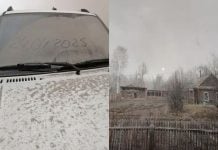
Within the volcanic risk literature, the typical focus of attention for global-scale catastrophes has been on large-scale eruptions with a volcanic explosivity index (VEI) of 7–8, which remain relatively rare.
However, many critical infrastructures and networks – shipping passages, submarine cables, and aerial transportation routes – all converge in regions where they could be exposed to moderate-scale volcanic eruptions (VEI 3–6).
This new study warns that relatively small but active volcanoes could cripple these vital infrastructures, essential to sustain our societies and to ensure their continued development, and cause a “ripple effect” around the world.
For example, they fear that minor eruptions on Vesuvius and Santorini could be as devastating if not more dangerous than colossal explosions, “cascading” into global catastrophe.
Giant waves could break submerged cable networks and even seal off the Suez Canal, according to a new study.
Ash clouds and landslides could also lead to financial market shutdowns and major food shortages, leaving the planet in a political tower.
Seven critical points
They have identified seven “critical points” where the groups of these volcanoes are next to the critical infrastructure for the functioning of society and the economy.
These regions include the northwestern United States, Taiwan, North Africa, and the North Atlantic.
1. Taiwan
The volcanic cluster in the far north of Taiwan could bring the global tech industry to a halt.
It is home to one of the largest electronic chip producers, as well as the Port of Taipei.
2. Mediterranean
Another trouble spot is the Mediterranean where legends from the classical world such as Vesuvius and Santorini could cause tsunamis.
These eruptions could not only destroy submerged cable networks, but even block the Suez Canal, a vital transportation route in Egypt.
Dr. Lara Mani, Center for the Study of Existential Risk (CSER), said: “We saw what a six-day closure of the Suez Canal did earlier this year, when a single container ship jammed cost up to ten thousand million dollars per week in world trade.“
3. Pacific Northwest
Eruptions in the US state of Washington in the Pacific Northwest could trigger mudflows and ash clouds that blanket Seattle, closing airports and seaports.
Scenario modeling for a magnitude six eruption of Mount Rainier predicts potential economic losses of more than $ 7 trillion over five years.
4. Malaysia/ Indonesia
In addition, highly active volcanic centers throughout the Indonesian archipelago, from Sumatra to Central Java, border the Straits of Malacca, one of the world’s busiest sea passages, with 40% of world trade traversing the narrow route each year.
5. Strait of Luzon, Philippines
Another key sea route, the Strait of Luzon in the South China Sea, is surrounded by the Luzon Volcanic Arc.
It is the heart of all the major submerged cables connecting China, Hong Kong, Taiwan, Japan and South Korea.
6. China and North Korea border
The researchers also identified the volcanic region that straddles the border between China and North Korea.
Columns of ash would disrupt the busiest air routes in the east, and an awakening of Icelandic volcanoes would do the same in the west.
7. Iceland
A magnitude four eruption of the Eyjafjallajökull volcano in Iceland in 2010 caused ash carried by northwesterly winds to shut down European airspace, paralyzing flights and causing a $ 5 billion loss to the world economy.
When Mount Pinatubo in the Philippines erupted in 1991, an eruption of magnitude six, some 100 times larger than in Iceland, its distance from vital infrastructure meant that the economic damage was less than a fifth.
Dr Mani said: “Even a minor eruption in one of the areas that we could identify generates enough ash or generates tremors large enough to disrupt the networks that are critical to global supply chains and financial systems.
“At the moment, the calculations are too skewed towards giant explosions or nightmare scenarios, when the most likely risks come from moderate events that disable the main international communications, commercial networks or transportation centers.
“This is true for earthquakes and extreme weather, as well as for volcanic eruptions.”
Dr. Mani and her colleagues said that smaller eruptions, ranked up to six on the “volcanic explosiveness index,” rather than the seven and eight that tend to occupy catastrophic thinking, could be some of the worst.
“It is time to change the way we view extreme volcanic risk,” added Dr. Mani.
“We need to stop thinking in terms of colossal world-destroying eruptions, as depicted in Hollywood movies.
“The most likely scenarios involve smaller eruptions that interact with our social vulnerabilities and cascade us toward catastrophe.” [CSer, Sun, Nature]
Now subscribe to this blog to get more amazing news curated just for you right in your inbox on a daily basis (here an example of our new newsletter).
You can also follow us on Facebook and/ or Twitter. And, by the way you can also make a donation through Paypal. Thank you!
You should really subscribe to QFiles. You will get very interesting information about strange events around the world.














Well, there you have it. A recipe for disaster. I can hear the satanic elitists revving up the HARP disaster machines. Lol
Another thing, if the depopulation agenda is on, then once the mass awakening to the kung-flu fraud, voter fraud, racial hoax fraud, and all the other frauds are exposed, it seems likely the satanic elitists will unleash that multi-pronged attack, hurry to their bunkers, and watch everybody die from a remote location while sipping adrenochrome cocktails.
If I were evil, that’s exactly what I would do? Why wait around for the pitchforks and torches?